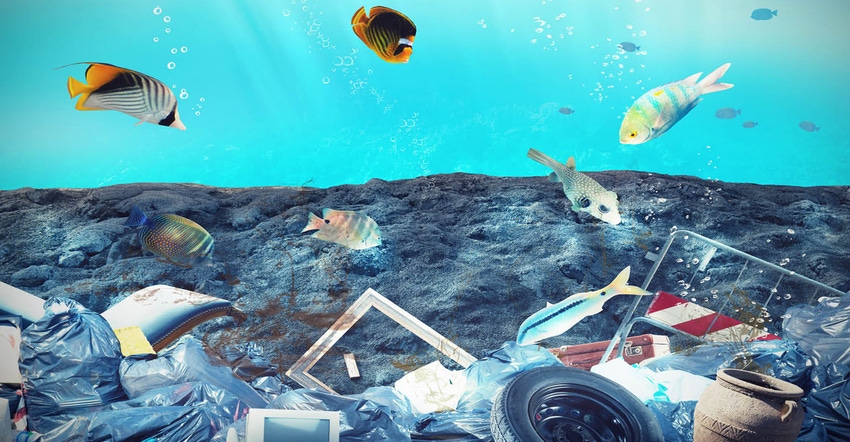At its Our Ocean 2017 conference last week in Malta, Ocean Conservancy announced its partners will support an investment initiative to raise more than $150 million to prevent plastics from entering the oceans.

At its Our Ocean 2017 conference last week in Malta, Ocean Conservancy announced its partners will support an investment initiative to raise more than $150 million to prevent plastics from entering the oceans. The initiative will fund waste management and recycling solutions in five Southeast Asian countries and focus on investments to improve collection, sorting and recycling markets.
“This is a major breakthrough in the fight for trash-free seas,” said Susan Ruffo, managing director of international initiatives at Ocean Conservancy, in a press release.
Research, she said, has found that improving waste management in Southeast Asian countries like China, Indonesia, Philippines, Vietnam and Thailand can cut the flow of plastic going into the ocean by 50 percent by 2025. And making funding available supports efforts by governments and local groups on the ground to improve their livelihoods and wellbeing while also improving ocean health, said Ruffo in a statement.
The new funding will be overseen by Closed Loop Partners, an investment firm that invests in companies, technology and recycling facilities to turn waste into value and advance the circular economy.
Among the consumer goods companies and plastics manufacturers committed to contributing are PepsiCo, 3M, Procter & Gamble, the American Chemistry Council and the World Plastics Council, which have fully funded the design phase of the fund, Ocean Conservancy said in a statement.
This initiative targets the source of ocean plastics by investing in the systems and technologies needed to collect and process waste into valuable commodities before it reaches the oceans, and it also funds specific solutions in the five South Asian countries.
Annually, 8 million metric tons of plastic enter the world’s oceans, at least 80 percent of that originating from land-based sources, says Nick Mallos, director of the Trash Free Seas Program. The funding is an exciting next step to correct this, he says.
Ocean Conservancy estimates the total cost for implementing solutions to end plastic waste in marine environments could be as much as $5 billion a year and offers solutions for decreasing the flow of plastic into the ocean by 45 percent in the next 10 years, with the ultimate goal of eradicating the issue by 2035. The funding initiative is another step toward those goals.
Among the key areas Ocean Conservancy has targeted to stem the flow of plastics into oceans are: industry, government and nongovernmental-organizations (NGOs), developing treatment options and strategically targeting initiatives in specific communities.
In the Ocean Conservancy’s report entitled "Stemming the Tide: Land-based strategies for a plastic-free ocean,", it specifically targets the important role of industry in driving solutions and bringing about public and private investment to solve the problem. The report offers a basis for global action, saying goals can be reached by collaboration among corporate and NGOs and represents emerging collaborative action across the consumer-goods value chain and between the private, public and social sectors.
In its report "The Next Wave: Investment Strategies for Plastic Free Seas.", which was released earlier this year, Ocean Conservancy calls for accelerated development of waste collection and a stop to the post-collection flow of plastic into the ocean. It lists effective solid waste management as a critical first step for reducing plastic waste in the ocean, which would result in more plastics being collected, separated, recycled and treated.
The continued lack of proper waste management practices fosters plastic leakage and fuels environmental problems, as well as having health and economic consequences. The changes and implementations to programs will have a long-term systemic effect on not just collection and treatment in those areas, but also in terms of a circular economy, says Mallos.
The report acknowledges the user benefits of plastics are undisputed and will continue to drive massive growth. The ICIS Supply and Demand database projects that plastic production will increase from about 250 million metric tons in 2015 to approximately 380 million metric tons by 2025. The regions that are the most responsible for ocean plastics also have some of the highest projected growth rates for plastic waste, and the quantity of plastic estimated to enter ocean environments in 2025 is double that of 2015.
The initiative will fund solutions tailored specifically to each region of those five South Asian countries. The agenda includes the recognition of ongoing efforts such as capital-light improvements to uncontained dumpsites near waterways and heavily penalizing waste haulers for dumping waste into waterways. Additionally, it calls for new priorities, acceleration of existing initiatives, increased private-sector commitment and a focus on ocean-smart measures geared toward reducing plastics heading to the ocean.
Ocean Conservancy says 75 percent of land-based plastics entering the oceans come from uncollected waste and 25 percent come from within the waste management system itself. Both improper dumping and poorly located formal and informal dumpsites or dumpsites that lack proper controls contribute to the problem.
Mallos adds that the importance of improving the waste systems is more than just building infrastructure. It is about education and outreach, as well. The systems really must be designed in collaboration with these communities, he says, and community members must be able to participate properly in order to make the systems both efficient and effective. Education and outreach also are key to successful implementation, he says.
The group plans to share the results of its initial phase of work within the next year to help build the field of investors looking to deploy capital into this market.
About the Author(s)
You May Also Like


